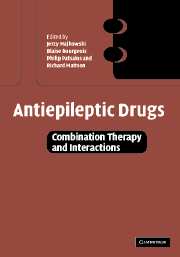Book contents
- Frontmatter
- Contents
- List of contributors
- Foreword
- Foreword
- Acknowledgements
- Part I Introduction
- 1 Combination therapy of diseases: general concepts
- 2 Combination therapy with antiepileptic drugs: potential advantages and problems
- 3 Pharmacogenetic aspects
- Part II Pharmacokinetic interactions
- Part III Pharmacodynamic interactions
- Part IV Drug interactions in specific patient populations and special conditions
- Part V Conclusions and future perspectives
- Index
1 - Combination therapy of diseases: general concepts
from Part I - Introduction
Published online by Cambridge University Press: 07 September 2009
- Frontmatter
- Contents
- List of contributors
- Foreword
- Foreword
- Acknowledgements
- Part I Introduction
- 1 Combination therapy of diseases: general concepts
- 2 Combination therapy with antiepileptic drugs: potential advantages and problems
- 3 Pharmacogenetic aspects
- Part II Pharmacokinetic interactions
- Part III Pharmacodynamic interactions
- Part IV Drug interactions in specific patient populations and special conditions
- Part V Conclusions and future perspectives
- Index
Summary
Many drugs are excellent when mingled and many are fatal
Homer 950 ECHistorical aspects
Combination therapy has been used since therapeutics was first practiced. The physician or asu of Mesopotamia in 1700 bc used combinations of several plants, minerals and animal products in concoctions, salves and fomentations (Lyons and Petrucelli, 1987). We know little of the efficacy or toxicity of these combined medications. However, the Babylonian code of Hammurabi states that a doctor who causes the death of a patient or loss of an eye should lose his hands. It would not have been surprising if such stringent punishments encouraged the use of a large number of non-toxic (and possibly non-efficacious) medicines. At least this would have ensured that the physician could continue to be able to mix his own preparations.
Since many early drugs were of plant origin, the use of single herbal preparations containing many potentially active ingredients resulted in combination therapy, albeit often unknowingly. Thus cannabis, advocated by the Red Emperor (Shen Nung) around 2800 bc contains around 30 cannabinoid compounds, and debate still rages today as to whether cannabis has greater therapeutic efficacy than single cannabinoid therapy (e.g. with delta-9 tetrahydrocannabinol) in certain medical conditions. Traditional Chinese medicines continue to be used regularly by up to half the population of China (Encyclopaedia Britannica, 1999), and contain several constituents prescribed in individualized doses in a bespoke fashion. The patient takes these ingredients home and boils them in a soup, before consuming the broth.
- Type
- Chapter
- Information
- Antiepileptic DrugsCombination Therapy and Interactions, pp. 3 - 15Publisher: Cambridge University PressPrint publication year: 2005
- 1
- Cited by

